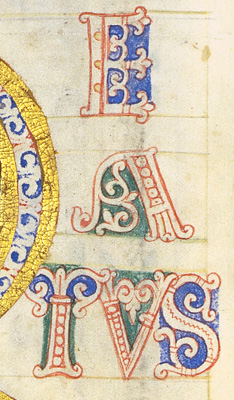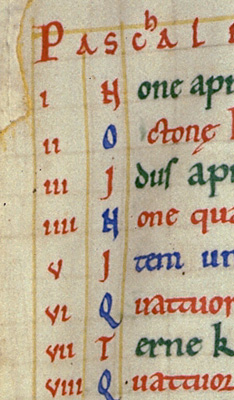| |
|||
CODICOLOGY |
||||||||||||||
|
CONTENTSThe St Albans Psalter consists of five discrete sections
PROVENANCEThe manuscript is owned by the parish church of St. Godehard, Hildesheim. It probably arrived there in 1803 when the monastery of Lamspringe, in the Hildesheim archdiocese, was suppressed. Most of the Lamspringe manuscripts were automatically transferred to the cathedral library and it is not known why the psalter found its way to St Godehard’s. Perhaps it was somehow in private ownership at that stage and was a personal bequest. Very faintly, on the top of the fly-leaf (p1) are written the words ‘L[iber] Monasterii Lambspring 1657’. Below this, in a bolder hand are the words ‘Liber Monast[erii] Lam/spring O.S.B. Cong[regationis] Angl[icanae’. The same hand wrote ‘ S1’ over an earlier inscription ‘A 5’. These are all written in the flowing handwriting of the 17th and 18th centuries. At the bottom left, written in a more controlled italic hand of the early 17th century, are the words ‘Fr[ater]: Ben[edictus]:’ At the top of p2, in a thin 18th-century hand, the Lamspringe ownership is repeated ‘Liber Monasterii Lamspringensis/ Ordinis Sancti Benedicti/Congregationis Anglicanae’. Lamspringe, about 20km south of Hildesheim, was founded in 873, secularised by the Lutherans and given to the English Benedictines in 1643. It became a congregation for emigré English Catholics fleeing the Civil War and later persecutions. One of the brethren must have taken the manuscript to Germany from England for safekeeping. Brother Benedict is one of the most common names taken in religion, but at Lamspringe in the mid 17th century only Robert Meering is recorded taking this name. He professed in 1658 and died in 1664. Perhaps he brought the book with him from England (AP, 5-6). The book was certainly still in England during the Reformation. The word ‘pape’ was systematically erased from the Calendar, as the result of orders from Henry VIII. See for example St Gregory,12 March, p 10. All the internal evidence indicates that the manuscript was written at St Albans Abbey in England. The litany has St Albans features; the hand which wrote the Chanson of St Alexis is found in British Library, Egerton MS. 3721, a St Albans calendar. Many features, including additions to the calendar, link the book closely to Christina, anchoress and later Prioress of Markyate (c. 1096- 1155/66). Evidence from Christina’s life indicates that her relationship with Geoffrey, abbot of St Albans from 1119-1147, gave rise to the compilation of the psalter in its final form. It is likely that the psalter spent most of the middle ages at Christina’s priory of Markyate, near St Albans in Hertfordshire and was rescued after the Reformation when it eventually made its way with a Benedictine refugee to Lamspringe. The detached page of Collects was discovered by Professor Hermann Schnitzler in the private collection of Dr Joseph Lütker and is now in the Schnütgen Museum, Köln (AP, viii).
|
||||||||||||||||||||||||||||||||||||||||||||||||||||||||||||||||||||||||||||||||||||||||||||||||||||||||||||||||||||||||||||||||||||||||||||||||||||||||||||||||||||||||||||||||||||||||||||||||
| 1 | 8 leaves | ff. 1-8 | pp 1-16 |
| 2 | 8 leaves | ff 9-16 | pp 17-32 |
| 3 | 10 leaves | ff 17-26 | pp 33-52 |
| 4 | 2 leaves | ff 27,28 | pp 53-56 |
| 5 | 8 leaves | ff 29-36 | pp 57-72 |
| 6 | 10 leaves | ff 37-46 | pp 73-92 |
| 7 | 10 leaves | ff 47-56 | pp 93-112 |
| 8 | 10 leaves | ff 57-66 | pp 113-132 |
| 9 | 10 leaves | ff 67-76 | pp 133-152 |
| 10 | 10 leaves | ff 77-86 | pp 153-172 |
| 11 | 10 leaves | ff 87-96 | pp173-192 |
| 12 | 10 leaves | ff 97-106 | pp 193-212 |
| 13 | 10 leaves | ff 107-116 | pp 213-232 |
| 14 | 10 leaves | ff 117-126 | pp 233-252 |
| 15 | 9 leaves | ff 127-135, | pp 253-270 |
| No. 8 in the gathering between pp266 and 267 has been cut out. | |||
| 16 | 10 leaves | ff 137-145 | pp 271-290 |
| 17 | 10 leaves | ff 146-155 | pp 291-310 |
| 18 | 10 leaves | ff 156-165 | pp 311-330 |
| 19 | 10 leaves | ff 166-175 | pp 331-350 |
| 20 | 10 leaves | ff 176-185 | pp 351-370 |
| 21 | 10 leaves | ff 186-195 | pp 371-390 |
| 22 | 10 leaves | ff 196-205 | pp 391-410 |
| 23 | 2 leaves | ff 206, 207 | pp 411-414 |
| Missing leaf after p414 in Schnütgen Museum, Köln | |||
| 24 | 2 leaves | ff 208, 209 | pp 415-418 |
(The last two quires were amalgamated when the book was rebound. Pp 411/412 is a singleton glued to some reused medieval parchment containing palimpsest writing; 413/414 is a singleton glued to modern paper, both additions to create bifolios; the bifolio 415-418 forms the centre of the gathering followed by the new blanks.)
The Calendar, quire 1, is written on deep cream-coloured vellum which has a suede texture on the hair side and is shiny on the flesh side. The ruling is done in lead and orange crayon and the ruled space measures 18 x 13.5 cm, with 35 lines to the page, 0.6 cm apart.
The miniature cycle, quires 2-4, is painted on vellum ranging from deep cream to a brownish tone, warmer than the calendar. The hair and flesh sides are clearly distinguished. The flesh sides are smooth and shiny, showing marks from the knife which cause parallel striations. Relatively crisp, springy texture. The ruling is done with lead and the ruled space measures 18.1 x 14.1 cm
The Alexis quire, quire 5, p57-72, is written on deep cream vellum with a noticeable suede texture on both sides. The vellum is very supple and almost transparent in places. The ruling is variable, barely visible in parts and with evidence of free hand writing on many pages. There is no evidence of ruling on pp57-60. As a result, pp58 and 59, both with 35 lines, occupy 22 and 21.1 cm written space respectively and the lines at the bottom of p59 begin to slope downwards. Lightly scored horizontal lines begin to appear on p61, and on p63 and 64 double vertical lines are used on the outer margin. From p65-68 there are faintly scored horizontal and vertical lines. Ruled space, 21.6 x 14.4 cm. However, on p68 the horizontal guide lines are ignored so that 35 lines of text are squeezed into 32 scored lines.
The first two Emmaus pictures (p69-70) have ruled frames 21x 14.7cm and are placed symmetrically on the page. The third Emmaus miniature (p71) has a ruled frame 20.4x 13.1 cm, placed off centre on the page to allow for the adjacent commentary. The text occupies 55 lines, with no evidence of ruling.
The Beatus
Vir page (p72) was laid out in two stages. The first stage, defined
by faint silvery lines, laid out the spacing for the horsemen, the B and
the text. The second stage, defined by deep scored orange-tinted lines,
like those used in the calendar (p15),
saw the addition of the capitals EATUS VIR (see
COMMENTARY for p72). The adjacent text of 56 lines is unruled.
 Image © Hildesheim, St Godehard |
 Image © Hildesheim, St Godehard |
P72,
silver and orange lines |
P15,
silver and orange lines |
The psalter and prayers,
quires 6-23, are written on firm white vellum with flesh and hair sides
easily distinguishable. Page 73,
EATUS VIR, has a frame 19.1x13.3cm, different from all the previous
frame sizes. Pages 74 to 330
(first verso of quire 6 to end of quire 19) are lightly ruled with some
lead and possibly a sharp point: the ruling is barely visible. The ruled
space is 18 x 10.8 cm, with 22 lines per page. From p 331-
410 (quire 19 to 22) the pages
are heavily ruled with a sharp point and there are two columns measuring
20.4 x 5.9 cm). From p 411-414
(quire 23) the ruling reverts to the previous system and the scoring is
almost invisible. The pasted initial on p285
is greyer vellum, with a more suede texture than the page beneath.
A leaf missing after
p 414 is now in the Schnütgen
Museum, Köln. Its layout matches p414. It has been cut down to
27 x17.6 cm.
The final bifolium, quire 24, is of extremely thin vellum, deep cream to brownish in colour. The flesh side is noticeable shiny, smooth and looks waxy. Although these pages only contain full miniatures, they are ruled and pricked for lines, 0.9cm apart, like the earlier part of the psalm section (with no central columns). The ruling is done with lead and the ruled space measures 23.1 x 15.2 cm.
Most prick marks have been trimmed off. On p112, 6 prick marks are visible on the outer margin. On p417, thirteen prick marks at 9mm intervals remain on the outer margin. There is no pricking on the inner margins.
Several pages show perforations for stitching and even the red thread to hold fabric covers over the miniatures (p83). Whoever sewed them on made a conscious selection of images which were considered especially important. Some curtains were neatly stitched to the blank margins but in many cases (pp 101, 115,123,129,133,135) the stitches are immediately adjacent to the initial, pricking through the text itself. This indicates that the sewer valued the pictures far above the text because in these examples the text would be hard to read. The stitches protecting the initial on p83 pierce through the painted area on p84 where another curtain was more tidily stitched in the margin.
In the calendar only p10 and 12 were covered (Virgo and Scorpio), followed by the blank sheet (p16) at the end of the quire. This suggests there was once an illustration on this page but there is no evidence of erasure or paste. All the miniatures were individually protected (p17-56). Within the psalms, 72 out of 215 initials were protected, indicating an element of preference. Some mark the obvious large psalm divisions; many show women (p83, 140, 171, 173, 210).
If the decision to stitch indicates some value judgement about the painting, then the absence of stitches is also significant. There are no stitches in the Alexis quire, although it contains many impressive illustrations. The obvious show-piece, the pasted initial of Christina, p285, also had no covering. This could indicate it was a later insertion or that Christina herself, out of modesty, neglected her own portrait although the Litany showing her companions on p403 was covered. This suggests that the exercise of sewing in the silks was carried out and completed before the addition of the Alexis quire. In other words, it could have been done within Christina’s lifetime, so the choice of covered images and obstructed text could be her own.
From this elementary
analysis of the gatherings and contents, it is clear that the book was
constructed from five discrete elements: the Calendar; the full page miniatures;
the Chanson of Alexis; the Psalms, Creeds, Litany and Prayers; and the
last two illuminations. It is the relationship between these sections,
their scribes and artists which allows us to build up an understanding
of the date, purpose, patron and recipient of this book.
![]()
Go to |
Go to |
| • |
• |
• |
| A
collaboration between History of Art
and Historic Collections
University of Aberdeen - King's College - Aberdeen - AB24 3SW |
||